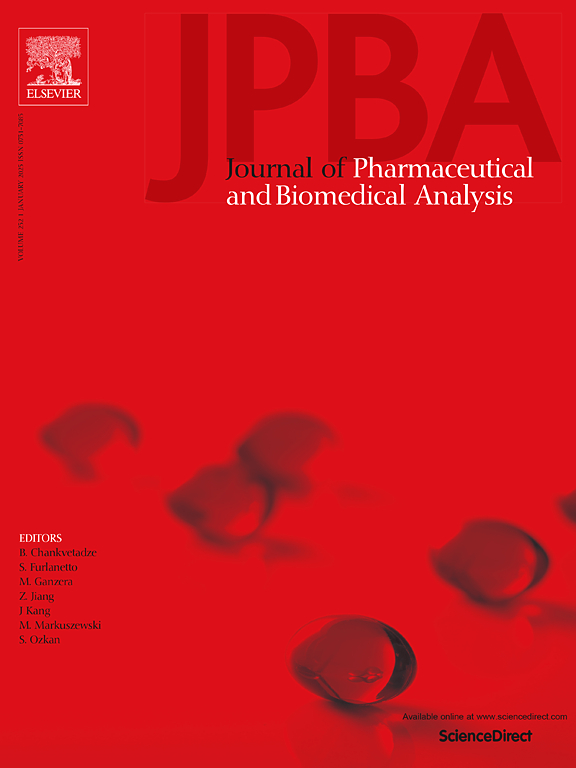Development of a sample preparation and analysis method for therapeutic monitoring of diazepam and major metabolite in alcohol withdrawal syndrome treatment
IF 3.1
3区 医学
Q2 CHEMISTRY, ANALYTICAL
Journal of pharmaceutical and biomedical analysis
Pub Date : 2025-03-06
DOI:10.1016/j.jpba.2025.116805
引用次数: 0
Abstract
Diazepam, a widely prescribed benzodiazepine, is frequently used for the management of alcohol withdrawal syndrome, anxiety, seizures, and muscle spasms. Its monitoring is critical due to its potential for abuse and the therapeutic importance of its metabolite nordiazepam. A sustainable and environmentally friendly high-performance liquid chromatography method was developed and validated for the quantification of diazepam and its active metabolite nordiazepam in human plasma samples. The chromatographic analysis was conducted on an HPLC system equipped with a UV detector. Separation was achieved using a Kinetex F5 column (150 ×4.6 mm, 5 µm). The mobile phase consisted of acetonitrile and phosphate buffer adjusted to pH 4.3 (30:70, v/v), delivered in isocratic mode at a flow rate of 1.0 mL/min, with the pH adjusted to optimize resolution. The method demonstrated excellent sensitivity, reproducibility, and linearity for both compounds, highlighting its applicability for drug monitoring and toxicological studies. Moreover, the environmentally conscious selection of materials and conditions underscores the method's compliance with green analytical chemistry principles. Both analytes were successfully detected and quantified in all fifty-three patients under the treatment of alcohol withdrawal syndrome. The measured concentrations of diazepam (0.23–1.4 µg/mL) and its metabolite nordiazepam (0.22–3.78 µg/mL) displayed considerable variability among individuals.
求助全文
约1分钟内获得全文
求助全文
来源期刊
CiteScore
6.70
自引率
5.90%
发文量
588
审稿时长
37 days
期刊介绍:
This journal is an international medium directed towards the needs of academic, clinical, government and industrial analysis by publishing original research reports and critical reviews on pharmaceutical and biomedical analysis. It covers the interdisciplinary aspects of analysis in the pharmaceutical, biomedical and clinical sciences, including developments in analytical methodology, instrumentation, computation and interpretation. Submissions on novel applications focusing on drug purity and stability studies, pharmacokinetics, therapeutic monitoring, metabolic profiling; drug-related aspects of analytical biochemistry and forensic toxicology; quality assurance in the pharmaceutical industry are also welcome.
Studies from areas of well established and poorly selective methods, such as UV-VIS spectrophotometry (including derivative and multi-wavelength measurements), basic electroanalytical (potentiometric, polarographic and voltammetric) methods, fluorimetry, flow-injection analysis, etc. are accepted for publication in exceptional cases only, if a unique and substantial advantage over presently known systems is demonstrated. The same applies to the assay of simple drug formulations by any kind of methods and the determination of drugs in biological samples based merely on spiked samples. Drug purity/stability studies should contain information on the structure elucidation of the impurities/degradants.

 求助内容:
求助内容: 应助结果提醒方式:
应助结果提醒方式:


